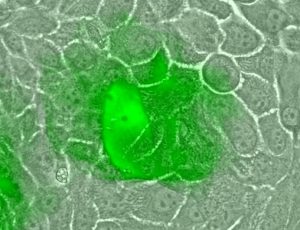Germain L, Zack DJ et al. Functional genomic screening identifies dual leucine zipper kinase as a key mediator of retinal ganglion cell death. Proceedings of the National Academy of Sciences of the United-States of America, 110(10):4045-4050, mars 2013.
Auteurs: Derek S. Welsbie, Zhiyong Yang, Yan Gea, Katherine L. Mitchell, Xinrong Zhoua, Scott E. Martin, Cynthia A. Berlinicke, Laszlo Hackler, Jr.a , John Fuller, Jie Fua, Li-hui Cao , Bing Han, Douglas Aulde , Tian Xue, Syu-ichi Hirai, Lucie Germain, Caroline Simard-Bisson, Richard Blouin, Judy V. Nguyen, Chung-ha O. Davis, Raymond A. Enke, Sanford L. Boye, Shannath L. Merbs, Nicholas Marsh-Armstrong, William W. Hauswirth, Aaron DiAntonio, Robert W. Nickells, James Inglese, Justin Hanes, King-Wai Yau, Harry A. Quigley, and Donald J. Zack
Impact scientifique: Le glaucome est une maladie neurodégénérative de l’oeil associée à la mort de cellules ganglionnaires de la rétine (CGR). Afin de développer de nouveaux traitements contre cette maladie, une expérience de criblage à haut niveau a été réalisée, permettant d’identifier la Dual Leucine zipper Kinase (DLK) en tant que protéine de signalisation nécessaire au processus de mort neuronale des CGR. Ces résultats ont été confirmés par des études in vitro et in vivo dans lesquelles la survie des CGR, suite à une atteinte neuronale, était favorisée par une sous-expression ou par l’inhibition de la DLK par un traitement au tozasertib. Une hausse d’expression de la DLK a également été notée suite à la transsection du nerf optique chez le rat. Grâce à ces recherches, la DLK et le tozasertib ont pu être identifiés respectivement en tant que cible et agent thérapeutique d’intérêt dans le traitement du glaucome et des maladies similaires.
Contribution du Réseau: Le RSSV a contribué à ces travaux grâce à l’élaboration d’une structure favorisant la recherche en santé de la vision qui soutient la réalisation de travaux comme en témoigne cette publication de haut niveau.
* * *
Résumé original
Glaucoma, a major cause of blindness worldwide, is a neurodegenerative optic neuropathy in which vision loss is caused by loss of retinal ganglion cells (RGCs). To better define the pathways mediating RGC death and identify targets for the development of neuroprotective drugs, we developed a high-throughput RNA interference screen with primary RGCs and used it to screen the full mouse kinome. The screen identified dual leucine zipper kinase (DLK) as a key neuroprotective target in RGCs. In cultured RGCs, DLK signaling is both necessary and sufficient for cell death. DLK undergoes robust posttranscriptional up-regulation in response to axonal injury in vitro and in vivo. Using a conditional knockout approach, we confirmed that DLK is required for RGC JNK activation and cell death in a rodent model of optic neuropathy. In addition, tozasertib, a small molecule protein kinase inhibitor with activity against DLK, protects RGCs from cell death in rodent glaucoma and traumatic optic neuropathy models. Together, our results establish a previously undescribed drug/drug target combination in glaucoma, identify an early marker of RGC injury, and provide a starting point for the development of more specific neuroprotective DLK inhibitors for the treatment of glaucoma, nonglaucomatous forms of optic neuropathy, and perhaps other CNS neurodegenerations.
La surexpression de la DLK, à la suite d’une transduction par des vecteurs adénoviraux dans des cellules épithéliales de peau en culture (en vert), induit des processus de différenciation et de mort cellulaire. Dans l’article PNAS, la DLK a été identifiée comme étant impliquée dans la mort cellulaire des cellules de la rétine.



